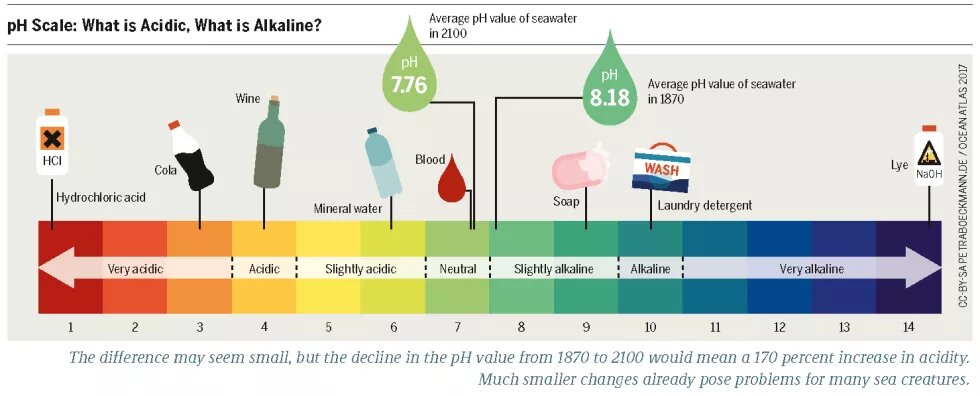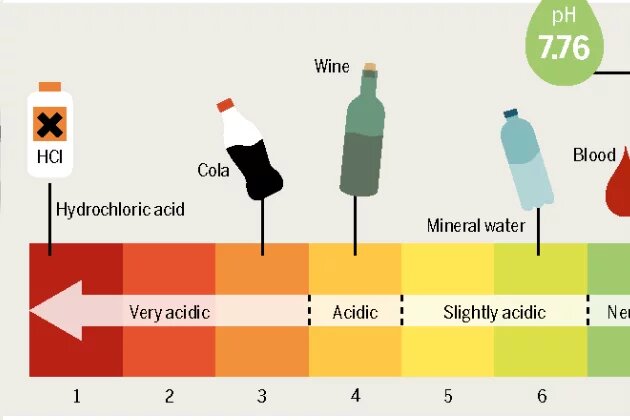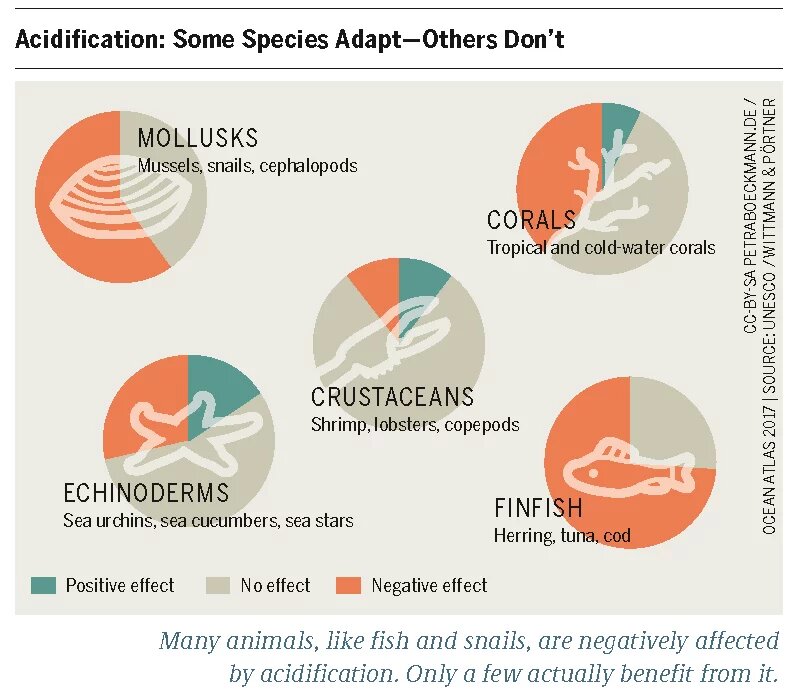
Our oceans are becoming more and more acidic. Though barely detectable to humans, for many of the animals that live there, the change is already proving fatal.

The four large upwelling zones near the west coasts of Africa and the Americas have been especially affected. In those areas, nutrient-rich water rises from deeper, darker layers up to the light-flooded areas near the surface. The nutrients they contain, like nitrates and phosphates, form the foundation of the food chain. They nourish phytoplankton (single-celled algae), which are eaten by zooplankton (tiny sea creatures). The zooplankton are in turn consumed by fish, which is why the upwelling zones are home to particularly rich fishing grounds.
The diversity of species and the shear number of organisms is especially great there: seven percent of biomass is produced there, and they are home to 25 percent of the fish catch. They are places full of biotic abundance and an important source of livelihood for millions of people. But this source of life and livelihood is threatened by acidification. Consider the upwelling zone off the coast of California. Since the Gold Rush in the 19th century it had been home to a flourishing oyster industry that supplied the delicacy to the entire country. But in 2005 the oyster farmers received an unexpected shock: the next generation did not appear. The oyster larvae had perished. The population did not recover in the years that followed and the West Coast oyster industry collapsed. Thousands lost their jobs.
What happened? The upwelling of deeper water in coastal regions changed. Researchers determined that the pH value of the water near the coast had declined starkly. The deep-sea water had thus transformed from a source of nourishment into a life-threatening environment. When the acid concentration became too great, the oyster larvae died. The researchers discovered that a portion of this increased acidification could be traced back to the CO2 that we have released into the air.
The Earth has always experienced periods of greater and lesser CO2 concentration, but today our oceans are acidifying at an unprecedented pace, faster than at any point in history. It is estimated that the oceans have already absorbed a third of the CO2 that we have emitted into the atmosphere since the Industrial Revolution. The result is a 26 percent increase in the acid content of the ocean.
What are the concrete effects of acidification? For one, it means that the CO2 in the water transforms into carbonic acid and the carbonate saturation decreases. That is a problem for all animals that use marine carbonate to make their shells, like mussels, snails, corals, sea urchins, and many others. The less carbonate there is in the water, the more difficult it is for them to make suitable shells. The effects can already be seen among foraminifera, tiny calcifying creatures that make up an important part of plankton: the shell-thickness of animals from the southern ocean has noticeably decreased compared to specimens from the pre-industrial period. The effect on oysters is slightly different: it has been observed that the thickness of their shells does not decrease, but only because they invest so much energy in shell production it stunts their overall growth. As a result, they are easier prey for predators like murex snails.
The situation is particularly critical for calcifying species in zones in which the carbonate saturation drops too far. In that case, the water actually begins to draw carbonate out of the shells, corroding them. This is already happening in some regions in Antarctica and in the North Atlantic: the cold-water corals that live there cannot maintain their chalk skeletons and will collapse. But other non-chalk-producing species, like fish, are also threatened. For instance, cod eggs have a very small chance of survival in general – 95 percent of the eggs die. If the water becomes more acidic, though, 97 percent will die – and that two percent decrease of already low odds is enough to endanger the future of the population.
What’s worse, the areas of the ocean with corrosive, calcium carbonate-dissolving water are spreading. In addition to the polar seas, the upwelling zones are under threat: the area off the coast of California will become fatally acidic in as little as 30 years. The ecosystems of the upwelling zones are especially endangered, because they are under pressure from the triple threat of acidification, warming, and oxygen-loss all at once. This trend may be fatal, because they are so crucial for the global food chain. The shocking failure of oyster farming in California shows that we can hardly predict the effects these stresses will have. For that reason we should not exacerbate them, whether through pollution, tourism, or overfishing.
» You can download the entire Ocean Atlas here.

